本文由 Moon Hoon 授权mooool发表,欢迎转发,禁止以mooool编辑版本转载。
Thanks Moon Hoon for authorizing the publication of the project on mooool, Text description provided by Moon Hoon.
Moon Hoon:柏林艺术家团体realities:united设计的装置Architecture of Autonomy和首尔建筑事务所Moon Hoon设计的View Folly共同组成了这个以“自治的建筑”为主题的装置,这是一种形成空间的装置,它定义了各种空间:外表面的前后空间以及由此衍生出的可用的内部空间,建筑的自主性便体现在表皮/立面与空间,或涉及到这两者关系的主题上。
Moon Hoon: The installation Architecture of Autonomy by Berlin based artist group realities:united is closely connected with the installation View Folly by Seoul based architect Moon Hoon. Architecture of Autonomy is an installation that forms space. It defines a front and a rear side or an external surface and the resulting usable interior space. The themes of surface (or façade) and space, or what is involved in the relationship between these two main aspects of architecture is the theme of the Architecture of Autonomy project.

在这个项目中,大家从各个层面对“表皮与空间”两者的整体性进行了质疑与探索剖析。外表面和内部空间被视为是松散的、独立的,它们并没有处于有机和绝对的联系之中,而只是以战略合作组织的形式存在着,每个要素只在特定的框架内运作联系,以达成它们各自的目标。
On various levels, the unity of these two aspects is questioned or dissected in this project. External surface and interior space are treated as loosely connected, independent players. No longer are they organically and absolutely connected, they rather form a kind of strategic or symbiotic alliance, whose members only contingently cooperate in the framework of a precisely negotiated subscription, thereby pursuing their own goals.
▼鸟瞰 Aerial
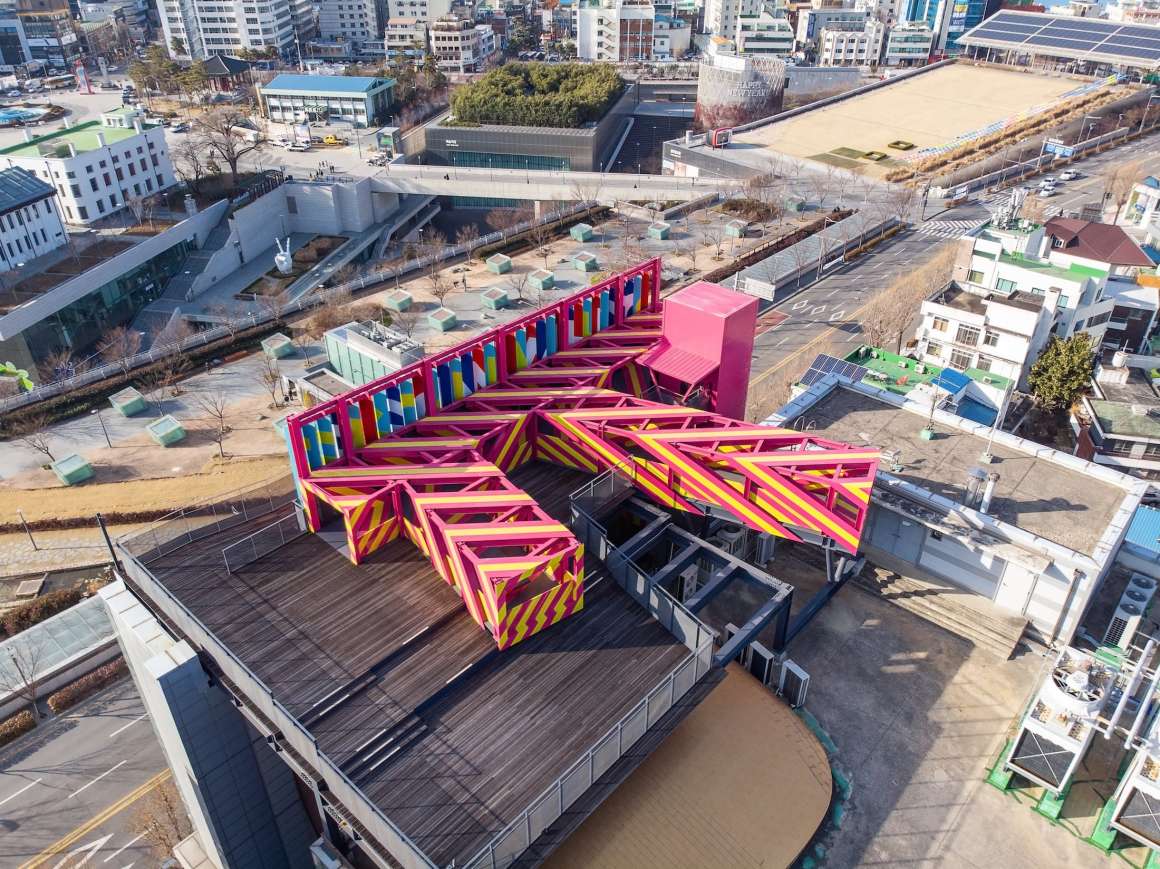
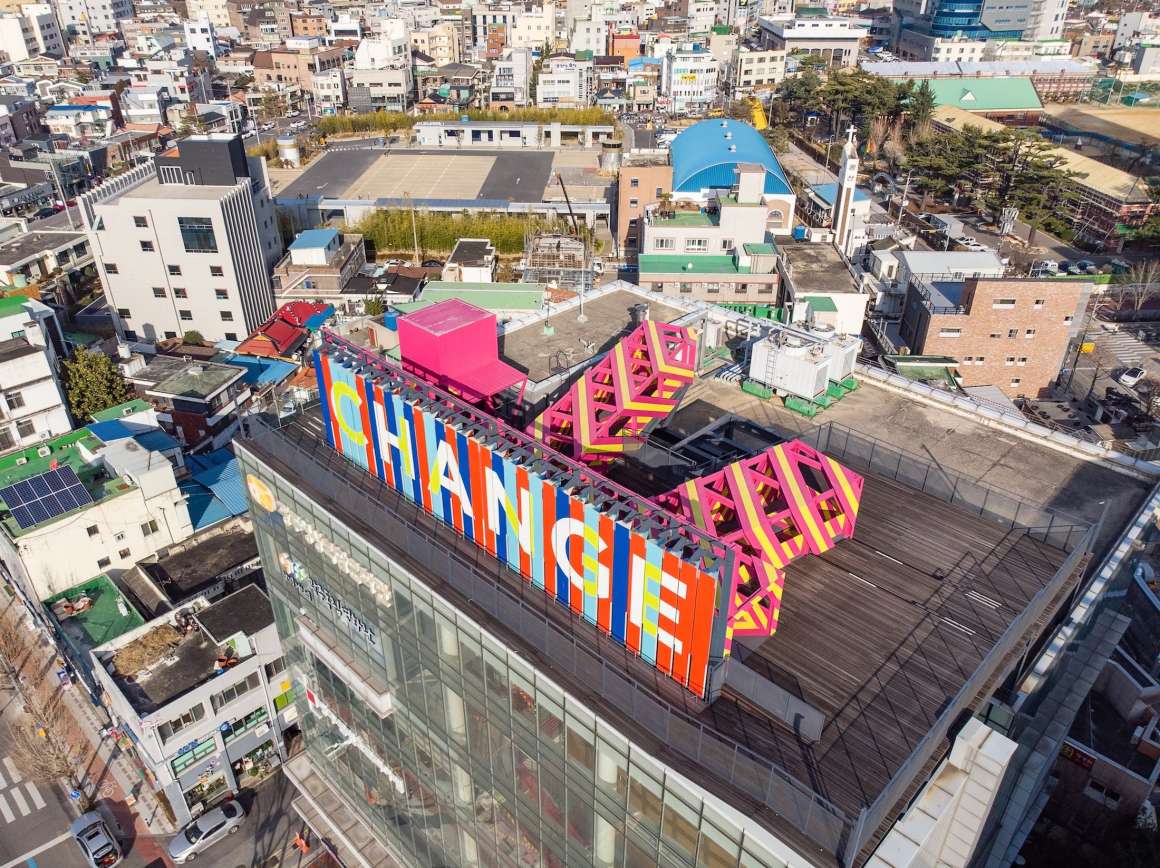
所以,在realities:united负责的外表面部分和Moon Hoon负责的外表面后的可用空间部分中,它们的概念和设计有着明显的区别。外表皮给予了内部空间一个视觉上的特征,可以让人们从远处就能识别到这个装置。反之亦然,互动装置的外表面为游客提供了简单的“互动式”体验,而藏在屋顶后表皮的“实体”空间则会使游客的体验感更加丰富。吸引人们爬上建筑楼顶到此参观的主要原因,大概是该装置极具吸引力的外表面,外表面与它后面的内部空间之间的转变共同为游客带来了良好的空间体验,同时这也是该装置设计概念的一个重要组成部分:人们最初感知到的各个组成部分的功能和意义是不一样的,经过更仔细的观察和体验后,外表皮与内部空间的界限会开始变得模糊。这个装置成为了吸引人们从远处攀登上来的目标,而室内的楼梯也为未知的攀爬过程带来了过渡式的体验。
Accordingly, there is a clear separation of conceptual and design responsibility between realities:united for the exterior surface and Moon Hoon for the usable space behind it. The exterior shell externally objectifies the interior space and gives it a visual identity or “address”, recognizable from afar. Vice versa, the initially invisible “actual” space on the adjoining rear roof surface supplements the visitors’ ultimately rather simple experience of the external “interactive” installation Architecture of Autonomy. This shift in the reference level between Architecture of Autonomy as “superficial attraction”, which presumably was a primary motivation to climb to this remote site, and the “usable level” behind it is an aspect of the experience of the overall ensemble. It is also a principal component of the overall concept: the initially perceived functions and meanings of the individual components move and, on closer inspection, begin to blur. The installation Architecture of Autonomy that, from afar, appears to be the goal of the climb on a closer look transforms into a kind of interim component or passageway to another, initially unknown experience behind it.
▼室内的楼梯为未知的攀爬过程带来了过渡式的体验 The installation Architecture of Autonomy that, from afar, appears to be the goal of the climb on a closer look transforms into a kind of interim component or passageway to another, initially unknown experience behind it.
装置外表面的两个主要功能包括:首先是它有典型的政治宣传工具的作用,从安全可靠的高度向城市传播信息;其次就是它的“互动性”和个人设计意愿的表达,这在人们深入思考时就开始起作用了。
The two initially dominant aspects of the exterior surface – namely, its effect as a typically authoritarian propaganda instrument whose message is broadcast to the city from a secure height, and second, its “interactivity” and expression of the individual person’s will to design – are set in motion as soon as one contemplates it more intensely.
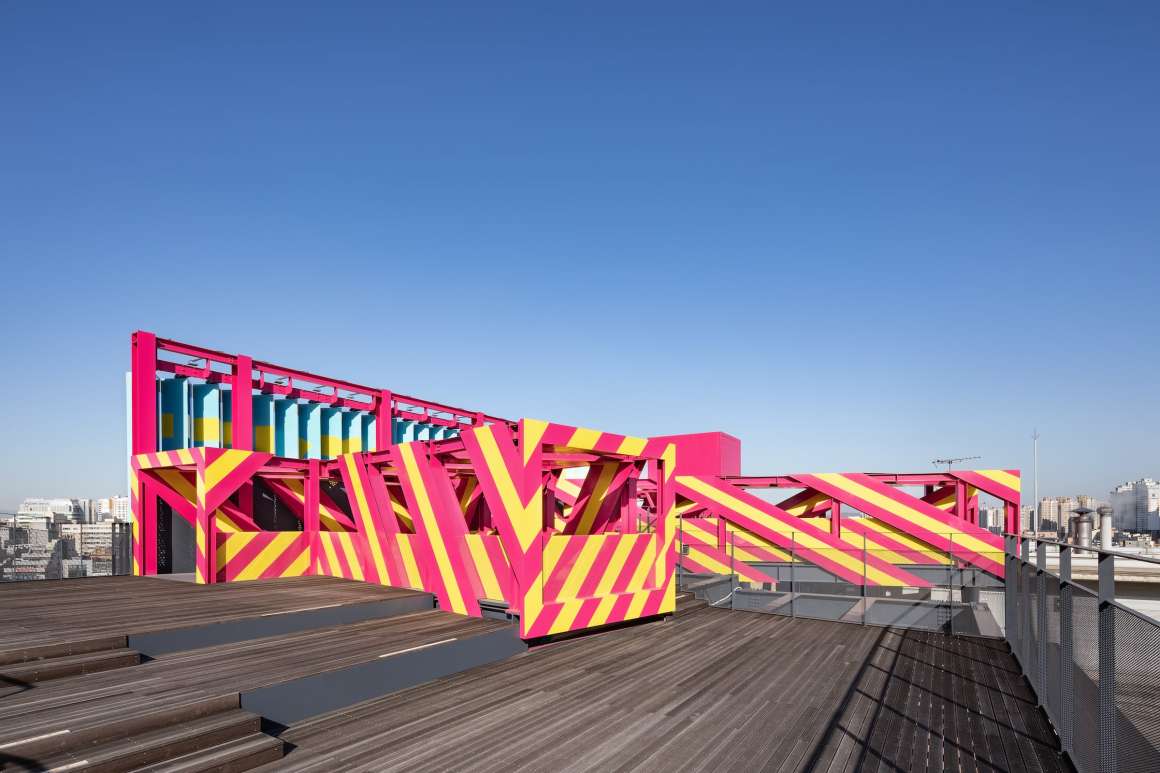
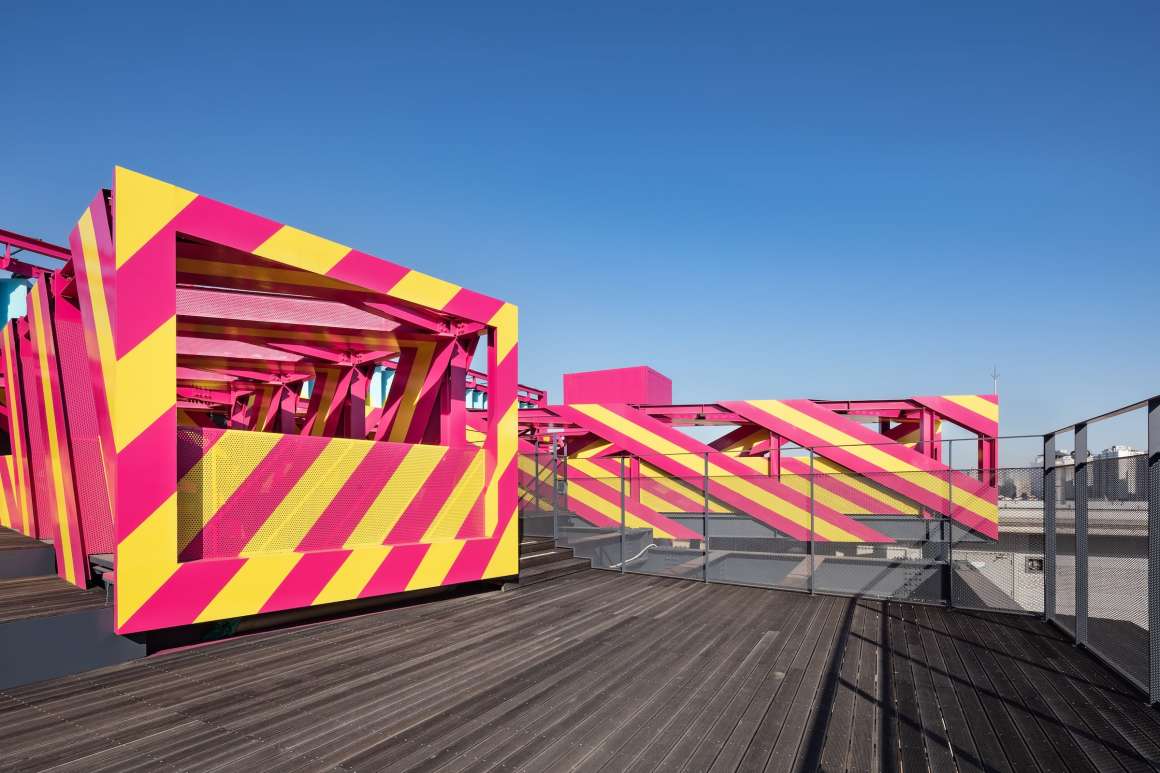
“改变”这个词是我们这个时代的中心隐喻,它的意思可能是模糊的或是自相矛盾的。2008年,“改变”一词成为奥巴马总统竞选的标志性口号,但在其继任期内,这个词又被明确地标记成了一种负面的残影。如今,这个词一方面是解放和民主化政治力量的关注焦点,另一方面又是新旧政权之间的关注焦点。例如,“改变”应该要能帮助消除社会歧视,促进性别、阶级、种姓和国家层面上的平等发展。但“改变”的观念一定程度上也分裂了社会,产生了差异。有些人认为改变至关重要,有些人却也害怕改变,有很多人希望政治制度和思哲观念能发生根本性的变化,但是这种追求最终会让自然或者社会保持一个稳定不变的状态,可以这样理解,继续当下的变革进程最终将把人们推向一个反乌托邦式的社会环境,在这样状态稳定的环境下将没有什么事物可以改变。
The term “Change”, visible from afar, is a central metaphor of our time. Simultaneously, its meaning is completely indeterminate or self-contradictory. In 2008, it became the trademark slogan of Barack Obama’s presidential campaign, but it is also clearly inscribed in his successor’s presidency as a kind of negative afterimage. Today, the term is at the center of attention between the political forces of emancipation and democratization, on the one hand, and those of old and new authoritarianism, on the other. For example, “change” is supposed to lead to equality and the elimination of differences between people – or to a return to structures, classes, castes, and nations that make it possible to avoid contact with what is different. But precisely the idea of “change” divides society and creates differences. There are those who consider change vitally important and those whom it frightens. Many want a radical change in the political system and the entirety of our political or philosophical thinking, but pursue the goal of ultimately preserving nature or society unchanged, with the explanation that continuing the current process of change will otherwise lead to a dystopian finalsteady state, one in which nothing more can be changed.
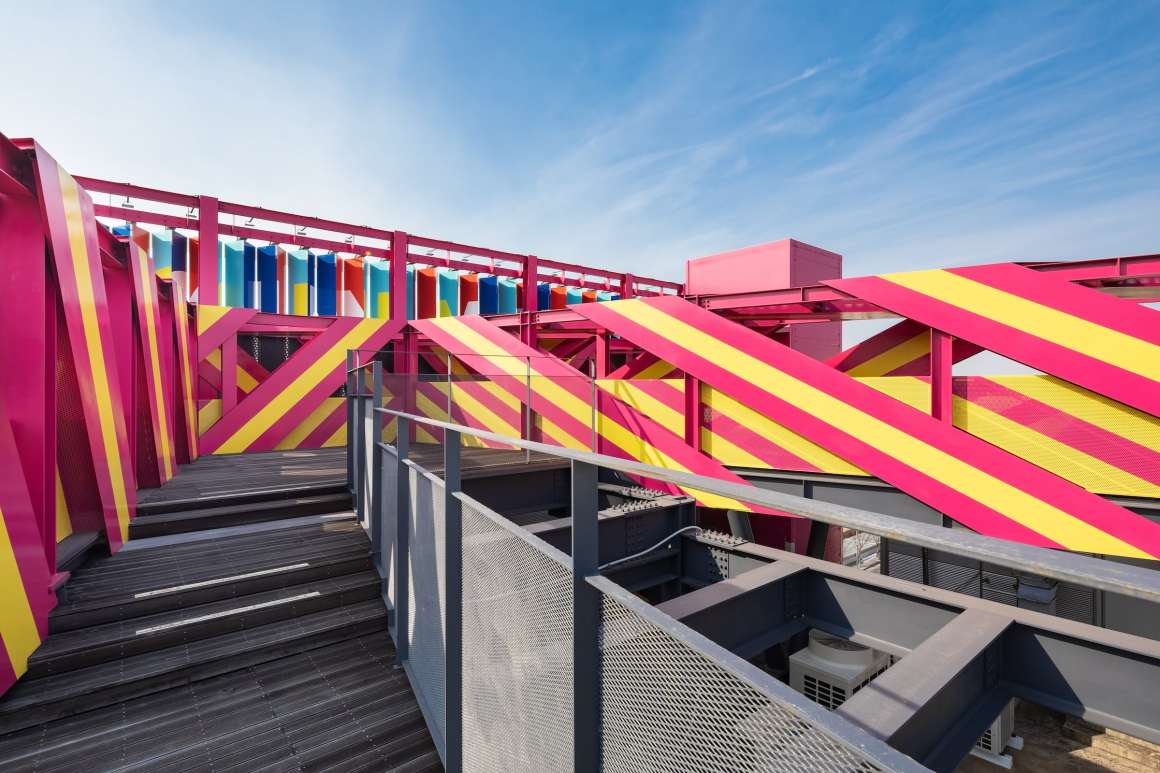

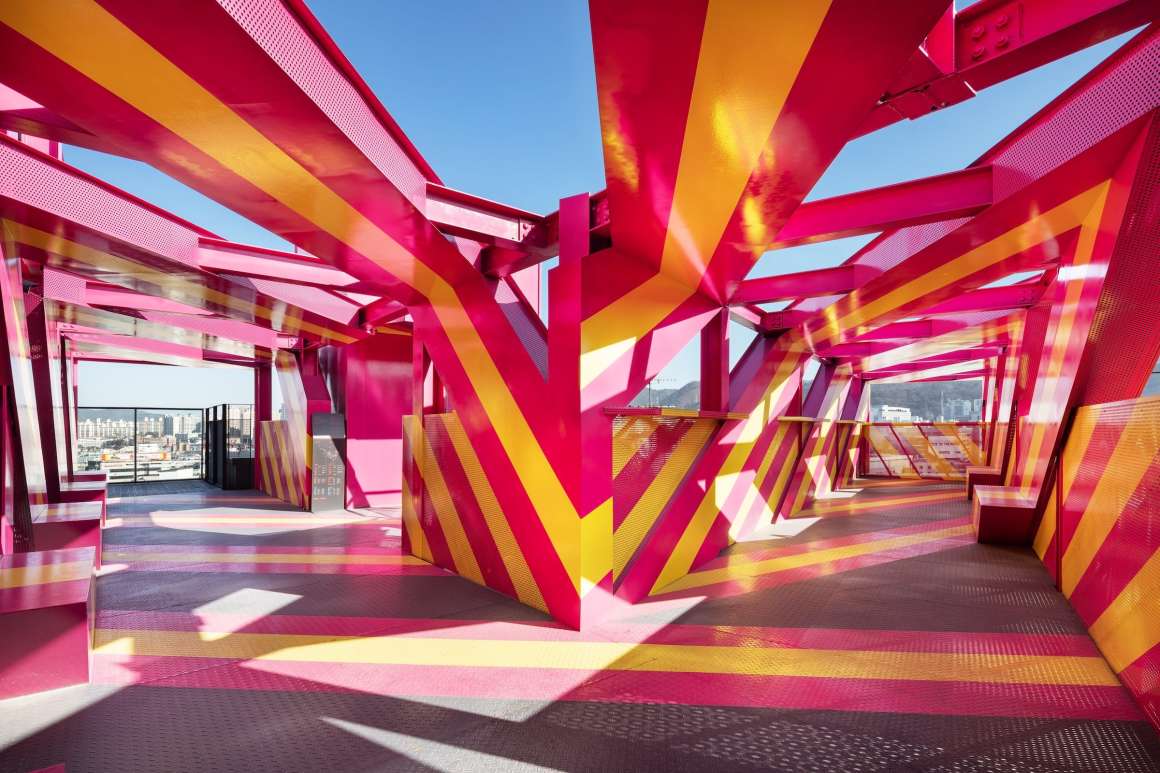
然而,“改变”一词描述了世界上亘古不变的变化过程,也涉及到了目前影响深远的变化,例如生活中各方各面的完全数字化,这种现象一方面伴随着人们对拥有新兴权力的乐观期望,另一方面也有对抽象的、心理技术的和独裁的体系的恐惧,而对这个体系的操控能力可能在一开始会毫无限制地增长。
The term “change”, however, also describes the unchanging process of the world that happens anyway, and which currently is once again involved in far-reaching change, for example through the complete digitization of every conceivable aspect of life. This, too, is accompanied by the euphoric expectation of an unprecedented empowerment of all people, on the one hand, and, on the other, by fear of an abstract, psycho-technological, authoritarian system whose capacities for control and manipulation could grow practically without limit for the first time.

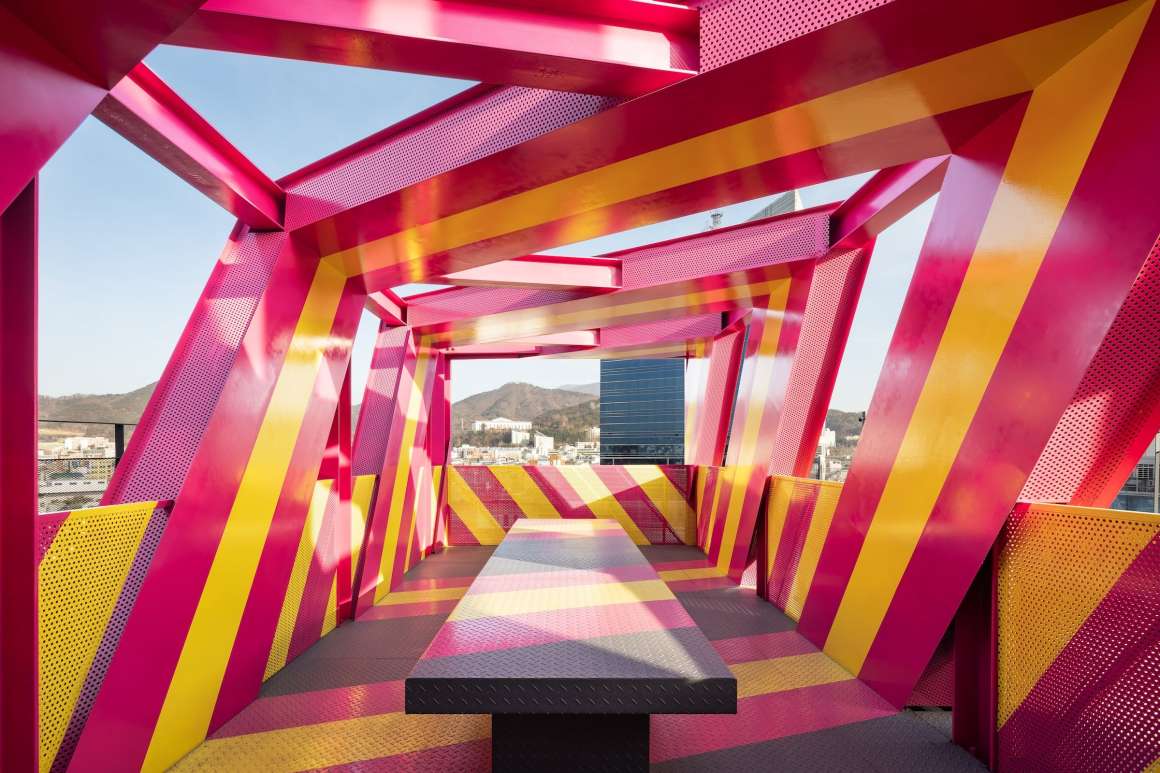
就我们今天所见,让每个人都参与到所谓的决策过程中来,其实是社会控制战略的一部分。“改变”是对个体(他/她以及自主地)往积极主动的方面发展的一个鼓励,这与呼吁合作甚至是征服并没有本质上的区别,归根结底,这取决于“改变”这种行为是否也包含改变互动体系。从真正的发展可能性和共同决策的意义上来说,开放互动与引导式合作之间的界限是不确定的,在某些情况下,这是为了人们控制或利用事物而建立的,具体表现在“互动”和“自愿”两个方面,最终会将人从内到外的每个方面都转化为一种交易商品,包括人们内心深处的愿望和动机。在这些两极之间,有各种各样的灰色地带以及社会个人利益,而它们实际上就像是参与和合作。
As far as we can see today, involving every individual in purported decision- making processes is part of the strategies of societal control. “Change” as a call to the individual to become (himself or herself, and autonomously) active does not essentially differ from the call to collaborate or even to be subjugated. Ultimately, it all depends on whether the possibilities to change also include changing the system of action. The boundary is fluid between open interaction in the sense of genuine possibilities of development and codetermination, and a guided collaboration that in some cases is set up for control or exploitation and that behaves “interactively” and “voluntarily”, but ultimately turns every aspect of the person, down to his innermost wishes and motives, into a trade good. In between these poles lie, in all shades of gray, various systems of social self-occupation that actually feel like participating and collaborating.
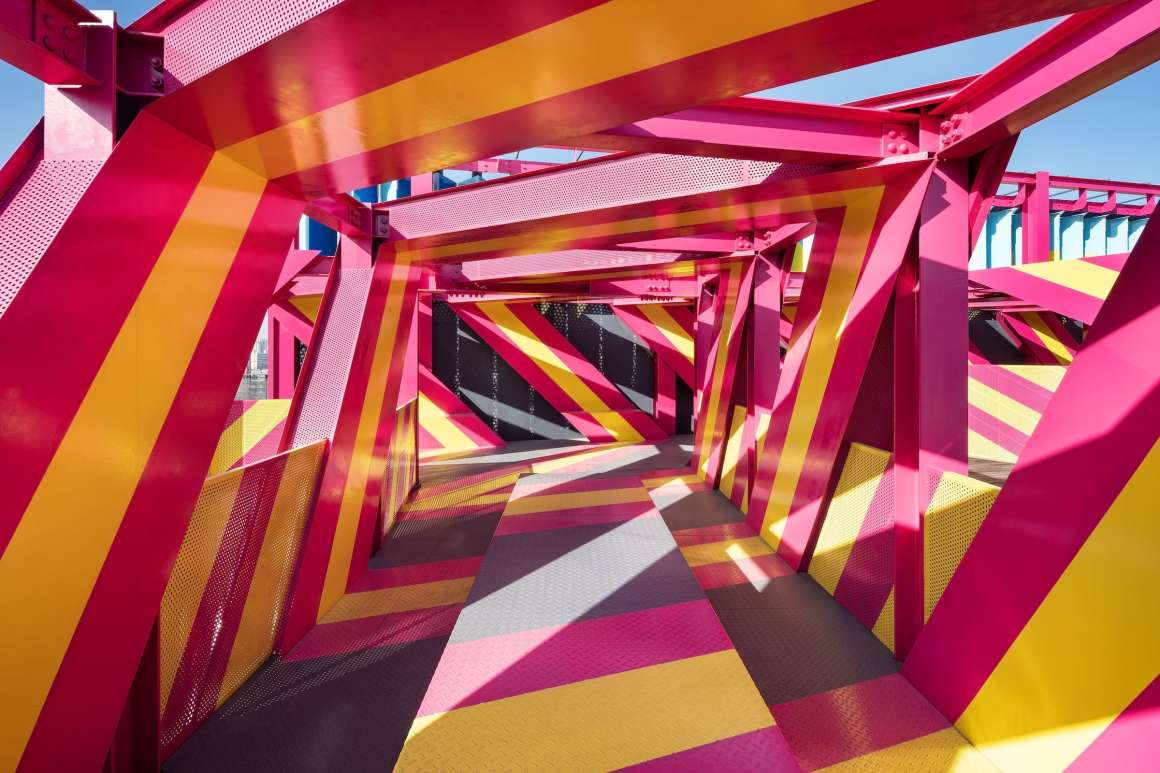
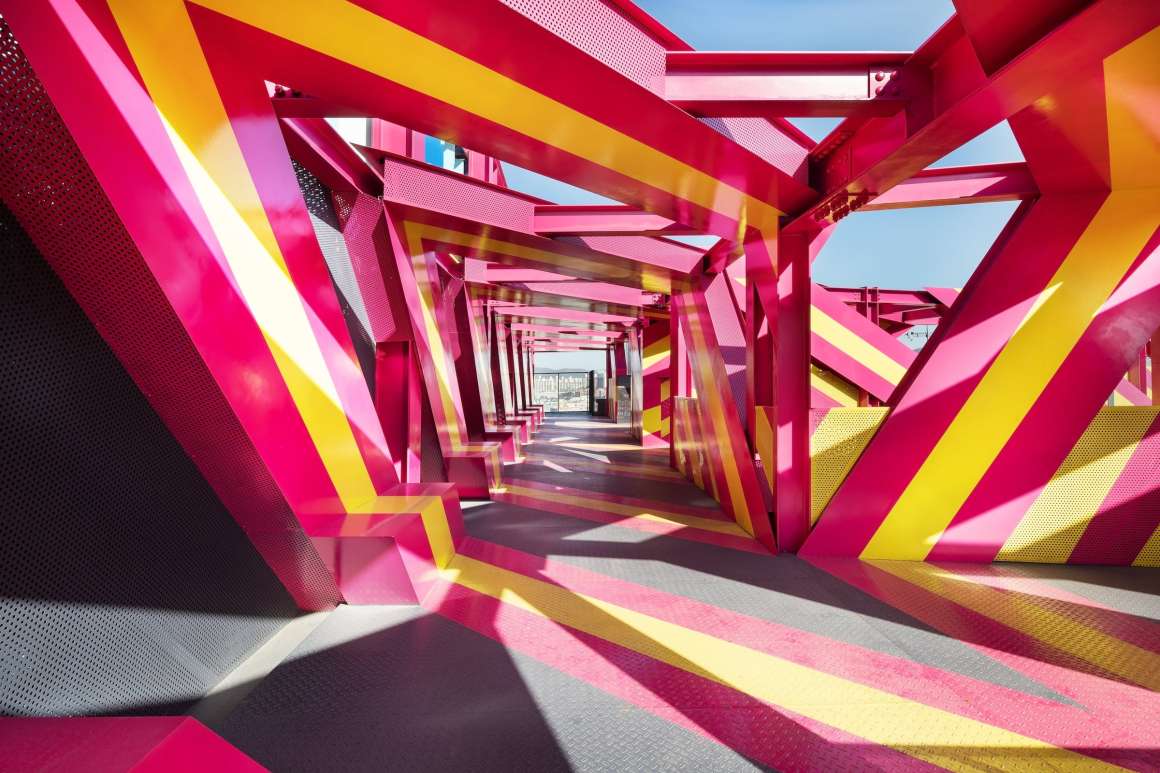
本案装置同样将“改变”与互动机会结合在一起,从而使展示墙本身成为改变的对象;它可以被配置成你意想不到的有2种不同颜色的图案。与商业广告的规范准则相比,这是一种实质性的干预可能。在商业广告中,色彩的每一个细微差别、每一种形式以及所有的内容都受到严格的、市场特定准则的约束。由于原始标语的文字保留在每种颜色的变体中,因此颜色模式是可变的,但是鼓励互动的中心文字信息却不是,受众无法改变系统及其中心信息,这似乎是一个潜在的矛盾,因为在这种特殊情况下,出现的问题是受众是否能够成功地被激励开展互动。通过约束大众潜在的变革力量,将人们互动-自愿式的合作理解为支持的标志,同时加强宣传合法性的意义,这样做是否能够同时吸收适度的互动干预,而大体上不作用于现有的等级制度,这个问题还没有得到解决。
The installation Architecture of Autonomy similarly combines the summons character of the slogan “change”, with an opportunity to interact, that in return makes the display wall itself the object of change; it can actually be configured to an unimaginable number 2 of different color patterns. Compared with the norms of commercial advertising, in which every nuance of color, every form, and simply all content is subjected to a strict, market-specific precept, this is a substantial possibility to intervene. However, the original slogan text is preserved in every color variant. The color pattern is thus changeable, but the central text message, calling for action, is not. The user cannot alter the system and its central message, which seems a latent paradox, because in this special case the question arises whether it is possible for the user to fulfill the summons successfully. The question is left unresolved whether enabling and simultaneously absorbing a moderate interactive intervention doesn’t primarily serve the existing hierarchical system by not only binding the populace’s latent revolutionary energy, but also by making it possible to interpret people’s interactive-voluntary collaboration as a sign of approval, in the sense of reinforcing the legitimation of the propaganda.
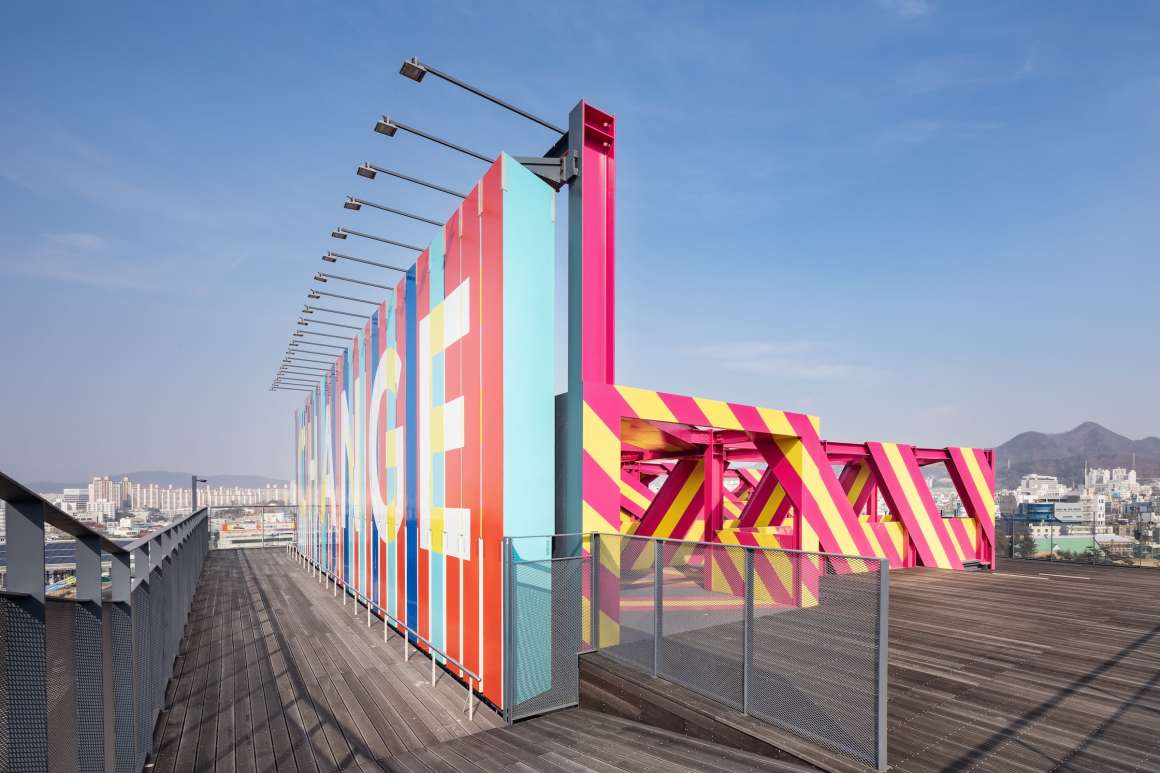
▼可以任意配置颜色的展示墙 The display wall can actually be configured to an unimaginable number 2 of different color patterns.
有这样一种情况,即手段与目的之间的传统区别会导致出现不明晰的结果,这除了体现在这个“自治的建筑”的体系结构中,也存在于由Architecture of Autonomy和View Folly组成的装置中。通过互动或作为社会场所的感知点而注入的“活力”,能够增强这种交流性外立面及其信息的有效意义,这就是为什么在短暂的“互动”之后,吸引游客并促使他们留在屋顶后面的平台上可以被看作是为达到这一目的所使用的手段。还有另一种理解方式:将交流度或吸引力的程度与有效的停留地点、花费时间的地点之间的关系理解为共生关系,就像花朵“支付”花蜜给参与劳作的昆虫,以传播或递送其自身的遗传信息。
Not only within the installation Architecture of Autonomy, but also in the combined installation consisting of Architecture of Autonomy and View Folly, there is a situation in which a conventional distinction between means and end leads to no clear result. The effective meaning of this communicating façade and its message increases through the “liveliness” breathed into it by interaction or through its perception as a societal site. This is why enticing visitors and inducing them to remain on the rear terrace after a short phase of “interaction” can be seen as means subordinated to this end. The alternative consists in understanding this relationship between the communicative or attractive level and the effective place to stay and spend time (behind the former) as a symbiotic relationship, like a flower that “pays” nectar to the participating insect for spreading or transporting its genetic message.
▼夜色下的构架 The installation in this night view
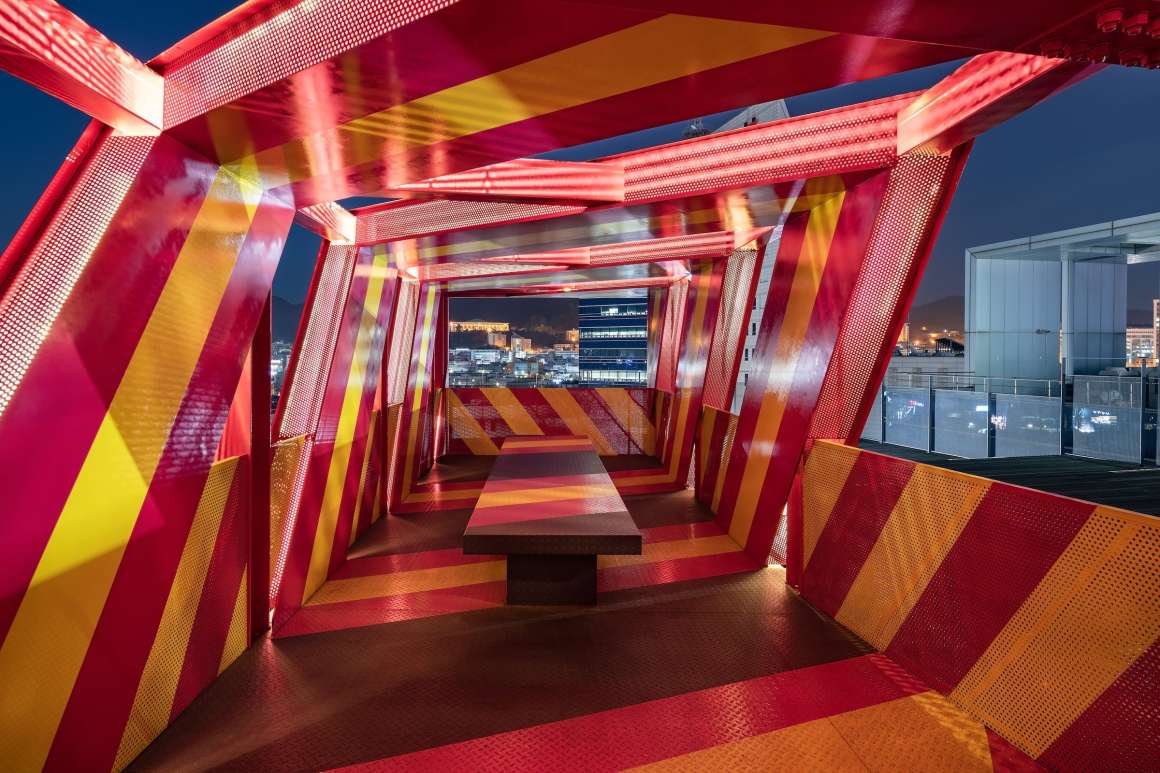
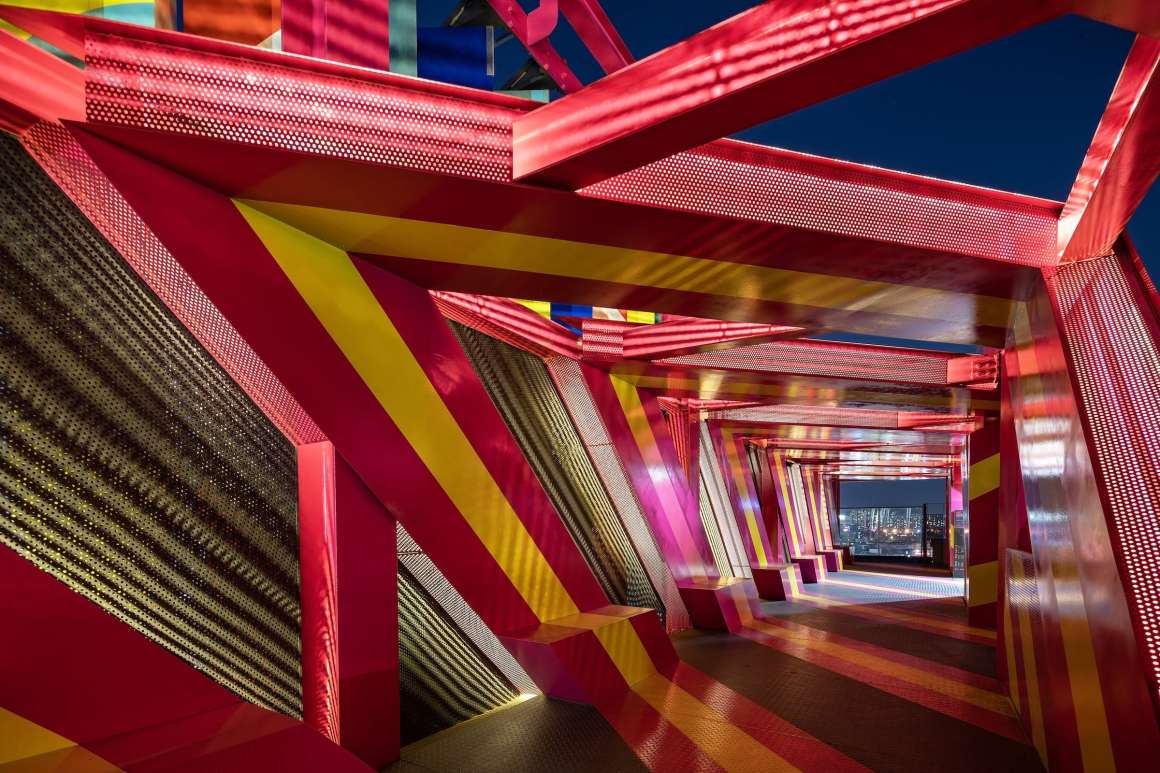
至此,我们又回到了一开始所阐述的观点:外表面与空间之间复杂的、共生的“契约关系”取代了传统的观点,即(外)墙将人造建筑空间与环境分隔开来,也就是说,创造空间的目标之一,便是筑墙。
With this, we return to the idea formulated at the beginning: a complex, symbiotic “contractual relationship” between façade and space forms a substitute for the conventional idea in which the (exterior) wall serves to delimit the manmade architectural space from the environment, i.e., in which erecting the wall is subordinate to the goal of creating space.
▼轴测图 Axonometric


▼平面 Plan

▼竖向分析 Elevation and Section
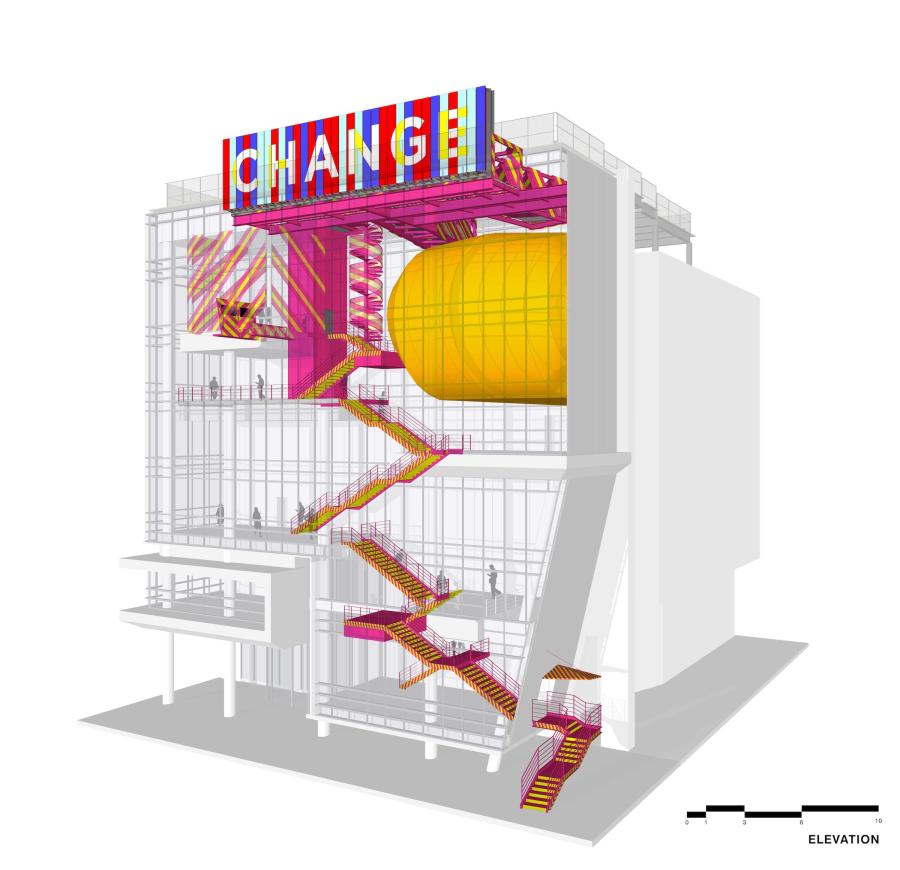

Design: Moon Hoon
Design team: Moon Hoon, jan edler, tim edler, Kim jaekwan, Kim sookhee, Kang changsu, Lee woohyun, Kim hyeri, Tomasz Kisilewicz
Photographer: kim chang mook
Location: 96, Jebong-ro, Dong-gu, Gwangju, Korea
Program: Culture Center+Commercial+Office
Site area: 1,595.68m²
Building area: 955.15m²
Gross floor area: 6,306.06m²
Building scope: B2 ~ 6F
Parking: 43
Height: 36.5m (Folly : 5.5m)
Building to land ratio: 59.86%
Floor area ratio: 255.34%
Structure: Steel Frame Construction
Exterior finish : paint Steel plate, Wood
Client : Gwangju biennale
Read more about: Moon Hoon


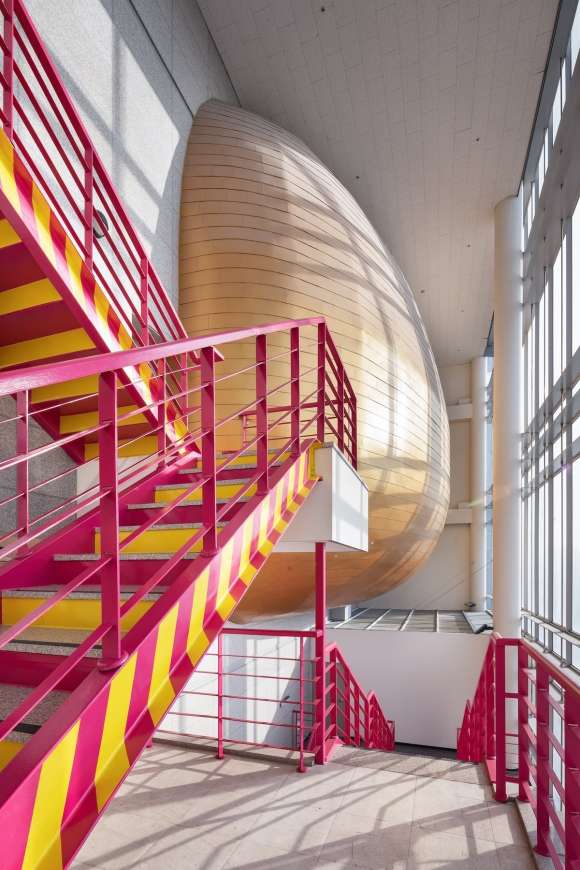
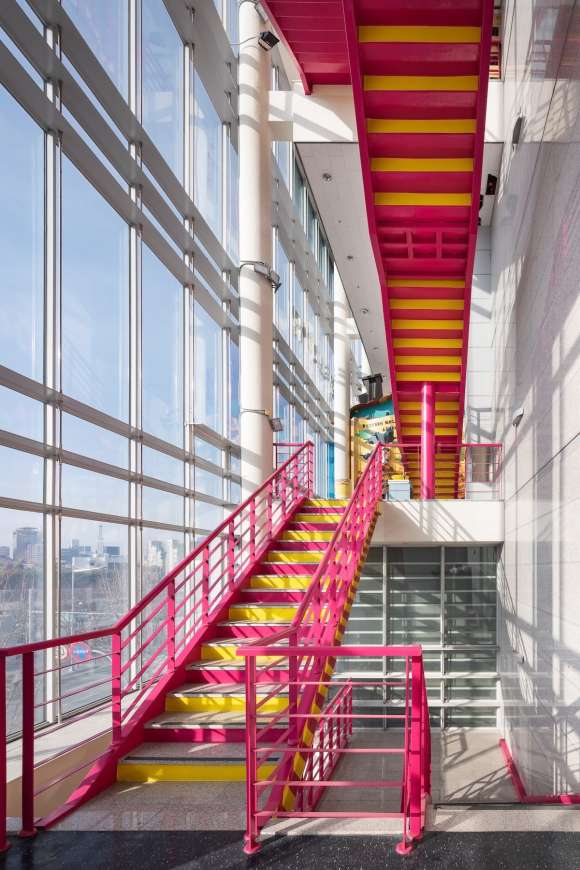
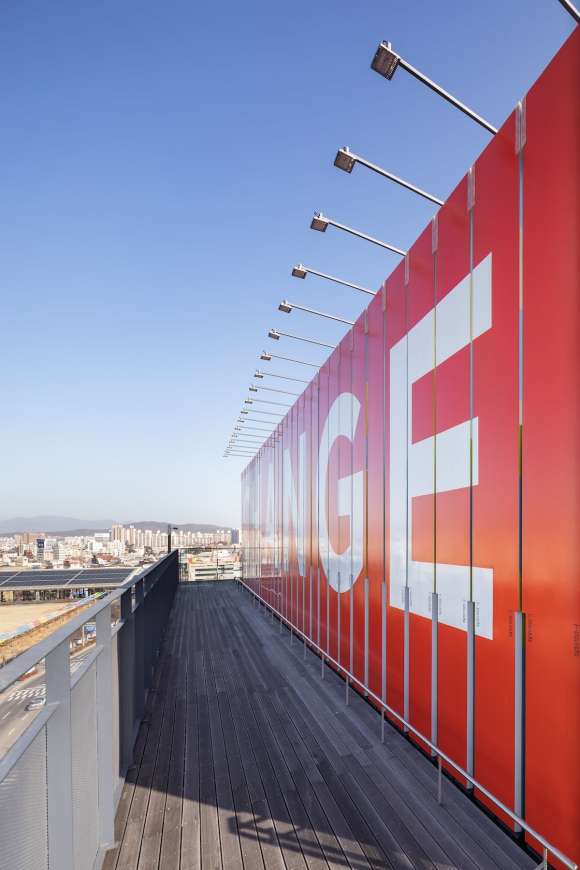
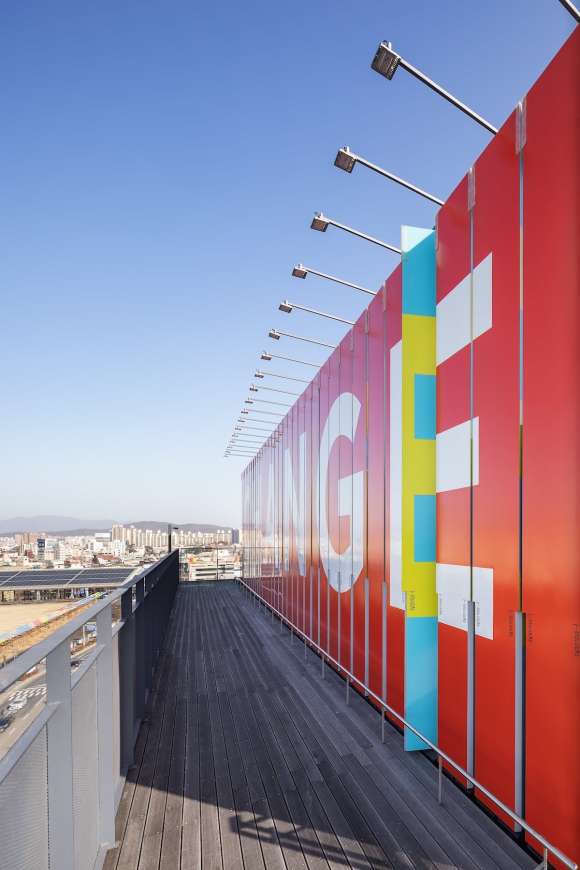

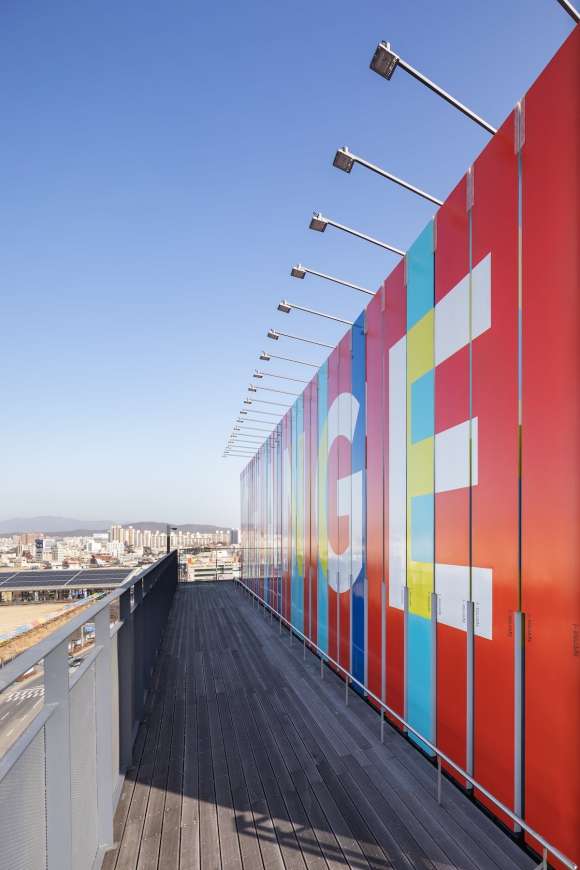


0 Comments